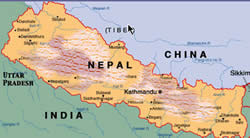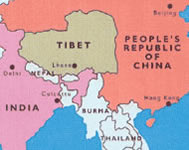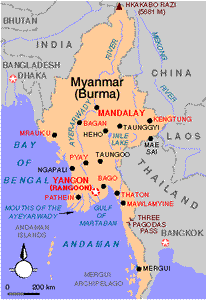Tibeto-Burmese Language Branch
Tibeto-Burmese (or Tibeto-Burman) branch constitutes a part of the Sino-Tibetan language family. It consists of 389 highly differentiated languages spoken over a widespread area from the Tibetan plateau in the north to the Malay peninsula in the south, and from northern Pakistan in the west to northeastern Vietnam in the east. It is thought that the Tibeto-Burmese peoples migrated from the Himalayas along river valleys and reached peninsular Southeast Asia by the first millennium AD. By the time of their arrival, this area was already settled Austro-Asiatic and Austronesian languages.
The existence of the Tibeto-Burmese language group was proposed in the 1850’s when it was noticed that words in written Tibetan were similar to their counterparts in written Burmese. Subsequently, British scholars and colonial administrators in India and Burma began to study some of the languages of the regional that appeared to bear resemblance to written Burmese and Tibetan. This early discovery and later investigations established the existence of the Tibeto-Burmese language branch.
The Tibeto-Burmese branch remains a relatively under-explored field, and there is no reliable classification for the genetic relationships among its various sub-branches. It is not possible to say exactly how many Tibeto-Burmese languages there are, how many of them are separate languages or dialects of one language, or even if there are still undiscovered languages. Many Tibeto-Burmese languages have been poorly recorded until recently, and many are still hardly known at all, all of which makes it difficult to classify them. Ethnologue lists 389 separate Tibeto-Burmese languages, but Matisoff estimates that the number of separate languages may actually be closer to 250 with the other languages being varieties of the same language.
Although the total number of Tibeto-Burmese speakers is only about 60 million, the number of individual languages is by far the largest of any language family in Asia. The most populous languages are Burmese with over 32 million speakers, followed by Tibetan spoken by some 6 million speakers. The table below shows the distribution of Tibeto-Burmese languages in terms of number of speakers (STEDT). With 131 languages that have under 1,000 speakers and another 123 with fewer than 10,000 speakers, it is clear that a good percentage of Tibeto-Burmese languages today are on the brink of extinction.
|
Number of speakers
|
Number of languages
|
|---|---|
|
under 1,000
|
131
|
|
less than 10,000
|
123
|
|
10,000-24,000
|
44
|
|
25,000-49,000
|
27
|
|
50,000-99,000
|
16
|
|
100,000-249,000
|
16
|
|
250,000-499,000
|
11
|
|
500,000-999,000
|
12
|
|
over 1,000,000
|
9
|
Status
The following Tibeto-Burmese languages have official status in their respective countries.
| Burmese | Myanmar |
| Tibetan | Tibet Autonomous Region and Tibetan Autonomous Prefectures in People’s Republic of China (along with Mandarin) |
| Dzongkha | Bhutan |
|
|
|
|
|---|
Dialects
Tibeto-Burmese languages present a complex dialect picture. Most have a number of distinct varieties , some of which are mutually comprehensible, as is the case in Burmese, and some which are not, as in the case of Tibetan which has several distinct spoken varieties that are in many instances not mutually comprehensible but that have over the centuries maintained a common literary tradition.
Structure
Sound system
The sound systems of Tibeto-Burmese languages, despite their great differentiation, share some important features
Syllabic structure
Tibeto-Burmese languages have a more complex sylllabic structure than Chinese, allowing consonant clusters.
Vowels
The number of vowels in Tibeto-Burmese languages varies with the average being somewhere between 6 and 8 vowels, plus several diphthongs.
Consonants
Like Chinese, Tibeto-Burmese languages contrast aspirated versus unaspirated stops and affricates, e.g., /p/ – /pʰ/.
Tones
Most Tibeto-Burmese languages are tonal. This means that pitch is an integral part of the pronunciation of syllables. Pitch distinguishes one syllable from another. The number of tones differs from language to language. For instance, Burmese has three tones, while Tibetan has two.
Grammar
Members o the Tibeto-Burmese branch tend to show some degree of agglutination. In an agglutinative language, affixes, each one with its own meaning, are added one after another to an unchanged root to express grammatical relations. In addition, postpositions are used to mark grammatical relationships.
Nouns
Tibeto-Burmese languages differ as to the extent of overt marking of grammatical categories in nouns.
- Nouns in some languages, e.g., Burmese, are not marked for gender, number or case, while in others, such as written Tibetan, they are marked for case, and to some extent, for gender and number.
- There is no agreement between nouns and their modifiers.
- Some Tibeto-Burmese languages, such as Burmese, require classifiers for quantifying count nouns, while in others, e.g., Tibetan, classifiers are not required.
Classifiers are used when counting or quantifying nouns.
Verbs
- Most verb roots are monosyllabic.
- Verbs in Tibeto-Burman languages tend not to be inflected for person or number.
- There is no agreement between subject and verb.
- Tense, aspect.and mood are marked by suffixes.
- Tibetan verbs fall into two main classes: volitional verbs and non-volitional. Volitional verbs represent actions under the speaker’s control, e.g., make, while non-volitional verbs represent processes not under the speaker’s control, e.g., recover. Non-volitional verbs lack an imperative stem.
- There is a complex system of honorific and polite verbal forms Thus, many verbs have a different form to express the superior status of the agent of the action.
Word order
The normal word order in Tibeto-Burmese languages is Subject-Object-Verb. Modifiers typically follow nouns.
Politeness
Politeness is grammatically marked. In Burmese and in Tibetan, for instance, there is a complex system of honorific and polite verbal forms with many verbs having a different form to express the superior status of the agent of the action.
Vocabulary
Tibeto-Burmese languages share a common stock of vocabulary. However, individual languages reflect different influences, depending on the country in which they are spoken and their history. For instance, Burmese has been influenced by Pali, English, and Mon, and to a lesser extent, by Chinese. Dungan has many Russian loanwords. Bodo has borrowed words from Assamese. Garo has many Bengali loanwords. Tibetan has taken many words taken from Sanskrit and Chinese.
Below are numerals 1-9 in Tibetan and Burmese in romanization and in the native scripts. .
|
Tibetan
|
||||||||
|---|---|---|---|---|---|---|---|---|
|
1
|
2
|
3
|
4
|
5
|
6
|
7
|
8
|
9
|
|
chig
|
nyi
|
sum
|
shi
|
nga
|
trug
|
dün
|
gyay
|
gu
|
|
|
||||||||
|
Burmese
|
|||||||||
|---|---|---|---|---|---|---|---|---|---|
|
1
|
2
|
3
|
4
|
5
|
6
|
7
|
8
|
9
|
10
|
|
thi
|
hni
|
thòun
|
lèi
|
ngà
|
chao
|
kún- hni
|
she
|
kò
|
seh
|
|
|
|||||||||
Writing
Tibeto-Burmese languages are written with a variety of scripts. Below are some examples.
| Burmese | Myanmar script | |
| Tibetan | Tibetan script | |
| Lepcha | Lepcha script | |
| Bodo | Devanagari script |
Difficulty
 How difficult is it to learn Tibeto-Burmese languages?
How difficult is it to learn Tibeto-Burmese languages?Burmese is considered to be a Category II language in terms of difficulty for speakers of English. There is no data on the difficulty level of other Tibeto-Burmese languages.


